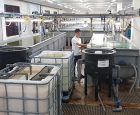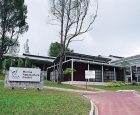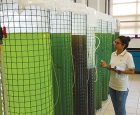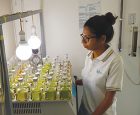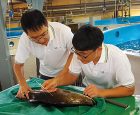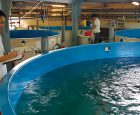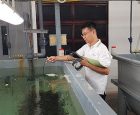
Features
Profiles
Spearheading aquaculture development in Southeast Asia
Located on St. John’s Island in Singapore, the Marine Aquaculture Centre (MAC) is a strategic initiative of the Agri-Food & Veterinary Authority of Singapore (AVA).
October 12, 2018 By Bonnie Waycott
 The Marine Aquaculture Centre in Singapore hopes to be the resource hub for tropical aquaculture research in the region.
The Marine Aquaculture Centre in Singapore hopes to be the resource hub for tropical aquaculture research in the region. Established in 2003, it develops and harnesses technology to facilitate the progress and expansion of large-scale hatchery and aquaculture production in Singapore and the region. Its key focus is tropical aquaculture, including fish breeding and genetics, nutrition and health and the development of aquaculture technology such as closed containment recirculating aquaculture systems (RAS).
Asian sea bass a focus
As aquaculture continues to flourish in Singapore, one species with particular promise is the Asian sea bass (Lates calcarifer), which has been cultured in Southeast Asia since the 1980s. MAC collaborates with local industry and research institutes in key initiatives for the species, such as genetic improvements through selective breeding for faster growth and disease resistance, and the application of RAS technology with accompanying culture protocols for intensive fry production.
“We are particularly optimistic about Asian sea bass,” says Dr. Jiang Junhui, deputy director at MAC. “We are now near the stage where superior quality fry will be produced for the industry through commercialisation by our research partner, and this will contribute to aquaculture production in Singapore and the region.”
Asian sea bass is an increasingly sought-after item on the menu with its white meat and soft, flaky texture when cooked. Produced at an industrial scale in many Southeast Asian countries, including Indonesia, Vietnam and Thailand, it has good domestic demand in Singapore and is also shipped to the United States, Australia and Europe.
MAC has also developed intensive, indoor hatchery technology for large-scale fry production of several tropical species including Pompano (Trachinotus blochii) and Cobia (Rachycentron canadum), but focusing on Asian sea bass has proven to be the right choice, since a selective breeding program for the species has been established in 2003.
System specs
Located on a 1.8-hectare site, MAC is designed to carry out research and development across the entire hatchery production process, from fish breeding and live feed production to larval rearing and nursery. There are also facilities for fish nutrition studies, vaccine safety tests and the evaluation of commercial products.
“MAC houses infrastructure for aquaculture research such as replicate tank systems for feed trials while live feeds such as rotifers and microalgae and clean sources of fry are readily available. We welcome companies and research institutes to set up their R&D units within MAC,” Junhui says.
Hatchery
MAC obtains its Asian sea bass founding stocks from neighboring countries, such as Indonesia, Malaysia and Thailand, to start the selective breeding program with a diverse genetic pool and avoid inbreeding in future generations. Using advanced molecular techniques, broodstock are chosen for their high growth rates and disease resistance. For spawning purposes, stocking density is kept low at around five to 10kg/cubic meter, around 30 to 40 broodstock in a 40-cubic-meter tank (fibreglass tanks from 20 to 60 cubic meters are available at the hatchery). Two separate spawning facilities house 14 spawning tanks.
Newly hatched larvae are reared in a facility with a production capacity of around 500,000 weaned fry (~35-day-old) per month. The facility is home to eight units of 4-cubic-meter larviculture tanks that are used for the first two weeks of culture (these can stock around 120,000 newly hatched larvae). The larvae are then moved to 12 units of 5-cubic-meter weaning tanks for the subsequent three weeks of culture. Producing fully weaned fry (~0.1g) takes roughly five weeks. Until the larvae are weaned over to artificial diets, their survival rate can reach around 50 per cent, thanks to hatchery protocol developed for intensive indoor fry production. Stocking density is kept at around 30 larvae per liter.
Incoming seawater parameters are fairly constant with water temperature at around 29 to 30 Celsius, pH at 8 and salinity at 30ppt. Water parameters can also be adjusted to suit the requirements of different culture stages.
Pre-growing
Once fully weaned, the fry are transferred to the nursery and grown for another two months until they reach 15 to 20g. At this stage they are vaccinated and transferred to cages at sea.
During the nursery stage, the fingerlings are quite cannibalistic so they are graded weekly and sorted into respective tanks according to size, using an automatic fish grading system. Feed is dispensed by automatic belt-feeders but hand feeding also occurs at times to observe feeding response and spot abnormal behavior so mitigating measures can be carried out in a timely manner. Stocking density ranges from 10 to 30kg/cubic meter, and providing pure oxygen can increase the density further to 50kg/cubic meter.
RAS potential
RAS technology can be adopted to increase productivity and improve resilience to adverse external environmental conditions. MAC has initiated research in this field to achieve a high consistency in hatchery production, predictable survival rates and healthy fry. It also plays a key role in the AVA’s efforts to increase productivity in local farms, by setting up RAS and developing customized culture protocols for large-scale fry production.
Amos Koh, senior scientist at MAC, believes that RAS technology for hatchery production is well-established and ready for industry adoption.
“Hatchery production of marine fish fry in Southeast Asia has progressed over time, from outdoor pond-based to indoor tank production,” he says. “But these are essentially flow-through systems, which makes production susceptible to pathogen incursions and disease outbreaks, adversely impacting supply consistency.
“We initiated our RAS research to overcome these vulnerabilities. RAS has allowed us to develop a low salinity protocol for Asian sea bass fry production to combat diseases such as big-belly syndrome, which causes up to 90 per cent mortality over a week in three-week-old larvae.”
Sustainability
Along with RAS, rigorous measures are in place to ensure biosecurity and sustainability. Treated water is re-used to ensure safe, optimum water quality. Samples of larvae and fingerlings at different stages from every production batch are sent to the AVA’s Aquatic Animal Health Lab to be screened for diseases such as viral nervous necrotic (VNN) and iridovirus. All staff members are equipped with the right knowledge and training.
MAC is also aiming to minimize waste from hatchery production to improve environmental sustainability, by incorporating a denitrification system into RAS or integrating hatchery production with aquaponics.
Necessary research
“Fish and larval nutrition remain key research areas as quality fry is an important starting point of aquaculture,” says Junhui. “Recently, there has been a lot of research looking at feed formulation and nutritional supplements to improve the overall quality and growth of fish. But more applied research is needed to see the actual benefits they bring to the local fish species.”
Furthermore, with space constraints and competing needs in developing and developed cities, land-based aquaculture is likely to become more intensive, with more farms going into multi-tiered farming. According to Koh, future water treatment solutions will not just need to reduce the use of water, but also minimize carbon footprint and enhance treatment performance.
MAC aims to be a regional reference centre for tropical aquaculture research, and is looking at more collaboration with overseas research institutions and experts. Above all, it hopes to increase its local production of food fish to ensure a resilient food supply in Singapore and provide a crucial buffer in times of supply disruptions. It would also like to see the region’s aquaculture production develop sustainably, to contribute to food security.
“We are striving to develop technology and expertise in hatchery production,” Junhui says. “We envision Singapore as a regional aquaculture hub, where farms, research institutes and aquaculture companies come together to solve challenges related to tropical marine aquaculture. We welcome anyone who is interested in collaborating to reach out to us.”
For more information on MAC, please visit: www.ava.gov.sg
Print this page
Advertisement
- Threat looms over New Brunswick’s oyster industry
- Volunteers give life to century-old Australian hatchery
